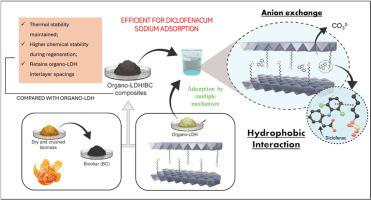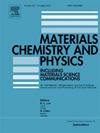从水溶液中去除双氯芬酸钠的有机-LDH 和生物炭复合材料
摘要
传统的层状双氢氧化物(LDHs)及其与生物炭的复合材料是去除水中双氯芬酸钠(DFS)等新污染物的有前途的吸附剂。然而,在这些复合材料中使用有机-LDHs 仍有待探索,而使用有机-LDHs 可增强其对有机分子的吸附性能。本研究探讨了以十二烷基硫酸钠为插层剂的有机 LDH(SDS-LDH)及其与橘皮生物炭的复合材料(SDS-LDH/BC)的合成、表征和应用,以去除水中的 DFS。将这些材料的吸附性能与 SDS-LDH 与橘皮生物质的复合材料(SDS-LDH/Bio)以及 SDS-LDH 和 SDS-LDH/Bio 热解得到的层状双氧化物(LDO)(分别称为 SDS-LDO 和 SDS-LDO/Bio)的吸附性能进行了比较。通过傅立叶变换红外光谱(FTIR)、X射线衍射(XRD)、扫描电子显微镜(SEM)、热重分析(TG)和pH值零电荷点分析对材料进行了表征,并在不同条件下对水介质中的DFS吸附情况进行了评估。XRD 和傅立叶变换红外光谱分析表明,十二烷基硫酸钠成功地融入了 SDS-LDH 的细胞间隙,这在 SDS-LDH/BC 和 SDS-LDH/Bio 复合材料中得到了保留。SEM 分析表明,SDS-LDH 结构的形状和大小各不相同,分散在生物炭的基质上,而 TG 分析表明,SDS-LDH/BC 与 SDS-LDH 具有相似的热稳定性。在 pH 值为 8.0、温度为 25 ℃ 的条件下,SDS-LDH 对 DFS 的去除率达到 90%,而 SDS-LDH/BC 在相同条件下的去除率达到 81%,对 DFS 的最大吸附量分别为 247 和 169 mg g-1,优于原始生物炭(无去除率)。在相同条件下,SDS-LDH/Bio、SDS-LDO/Bio 和 SDS-LDO 对 DFS 的去除率分别为 55%、36% 和 36%。这些结果揭示了 SDS-LDH 的层间结构在 DFS 吸附中的关键作用,XRD 和 FTIR 证实了这一点,表明 DFS 与十二烷基硫酸根阴离子在 SDS-LDH 的层间空间相互作用,特别是通过疏水作用。动力学研究表明,DFS 在 SDS-LDH/BC 上的吸附遵循伪一阶模型,而在 SDS-LDH 上的吸附遵循伪二阶模型,大约 30 分钟后达到平衡。Redlich-Peterson 模型令人满意地拟合了 SDS-LDH 和 SDS-LDH/BC 的吸附平衡等温线。虽然没有观察到生物炭和 SDS-LDH/BC 在吸附容量方面的协同效应,但 SDS-LDH/BC 复合材料的形成改善了 SDS-LDH 结构的保存,从而降低了重复使用时吸附容量的损失。这些研究结果表明,对这种先进材料的研究有助于开发更有效的基于生物炭-LDH 复合材料的吸附剂,特别是用于去除有机污染物的吸附剂。

Classic layered double hydroxides (LDHs) and their composites with biochar are promising adsorbents for removing emerging contaminants like diclofenac sodium (DFS) from water. However, the use of organo-LDHs in these composites remains unexplored and could enhance their adsorption properties for organic molecules. This study investigates the synthesis, characterization, and application of an organo-LDH based on sodium dodecyl sulfate as intercalating agent (SDS-LDH) and its composite with tangerine peel biochar (SDS-LDH/BC) for the removal of DFS from water. The adsorption performance of these materials was compared with those of a composite of SDS-LDH and tangerine peel biomass (SDS-LDH/Bio) and the layered double oxides (LDOs) obtained from the pyrolysis of SDS-LDH and SDS-LDH/Bio, referred to as SDS-LDO and SDS-LDO/Bio, respectively. The materials were characterized by FTIR, XRD, SEM, TG, and pH point of zero charge analyses, and the adsorption of DFS was evaluated in aqueous medium under different conditions. XRD and FTIR demonstrated the successful incorporation of sodium dodecyl sulfate into the interlamellar space of the SDS-LDH, which was preserved in the SDS-LDH/BC and SDS-LDH/Bio composites. SEM analysis revealed that the SDS-LDH structures, with varied shapes and sizes, were dispersed on the matrix of the biochar, while TG analysis showed that the SDS-LDH/BC had similar thermal stability to SDS-LDH. SDS-LDH achieved 90 % DFS removal at pH 8.0 and 25 °C, while SDS-LDH/BC reached 81 % removal under the same conditions, with maximum DFS adsorption capacities of 247 and 169 mg g−1, respectively, outperforming pristine biochar (no removal). Under the same conditions, SDS-LDH/Bio, SDS-LDO/Bio, and SDS-LDO removed 55 %, 36 %, and 36 % of DFS, respectively. These results revealed the pivotal role of the interlamellar structure of SDS-LDH in DFS adsorption, as confirmed by XRD and FTIR, which indicated that DFS interacted with dodecyl sulfate anion in the SDS-LDH interlamellar space, specially through hydrophobic interaction. Kinetics studies revealed that DFS adsorption on SDS-LDH/BC followed the pseudo-first-order model, while adsorption on SDS-LDH followed the pseudo-second-order model, with equilibrium reached in approximately 30 min. The Redlich-Peterson model satisfactorily fitted the adsorption equilibrium isotherms for both SDS-LDH and SDS-LDH/BC. Although no synergistic effect was observed between biochar and SDS-LDH/BC regarding the adsorption capacity, the formation of the SDS-LDH/BC composite improved the preservation of the SDS-LDH structures, allowing for a lower loss of adsorption capacity upon reuse. These findings suggest that the study of such advanced material can contribute to the development of more effective biochar-LDH composite-based adsorbents, specifically for the removal of organic pollutants.

 求助内容:
求助内容: 应助结果提醒方式:
应助结果提醒方式:


